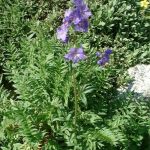| Common Name: |
Greek Valerian |
| Other Names: |
Jacob's Ladder, Charity |
| Botanical Name: |
Polemonium caeruleum |
| Genus: |
Polemonium |
| Family: |
Polemoniaceae |
| Native Location: |
N and C Europe, N Asia |
| Cultivation: |
Moist soil in sun or partial shade. Polemonium caeruleum tolerates alkaline conditions; P. reptans prefers rich soil. Cut back flower stems to base after flowering, unless seed is required. |
| Propagation: |
By seed sown in autumn or spring; by division in spring. Cultivars may not come true from seed. Polemonium caeruleum may self-seed excessively in optimum conditions. |
| Harvest: |
Plants (P. caeruleum) are cut in summer for infusions. Rhizomes (P. reptans) are lifted in winter and dried for use in decoctions and tinctures. |
| Variations: |
f. album
syn. Album
Has white flowers. |
Blanjou
syn. Brise d´Anjou
Has white-variegated leaves. |
|
| Height: |
30-90cm (12-36in) |
| Width: |
30cm (12in) |
| Hardiness: |
Z3-9 |
| Parts Used: |
Whole plant. |
| Properties: |
A slightly bitter, odorless, astringent herb that increases perspiration. |
| Medicinal Uses: |
Formerly used internally for a range of conditions, from headaches to fevers and epilepsy. |
| Bibliography: |
Encylopedia of Herbs by Deni Brown Copyright ©: 1995, 2001 Dorling Kindersley Limited pps. 325-326
|
